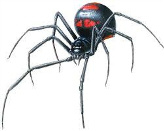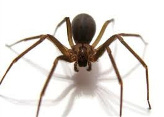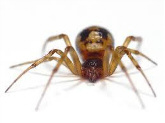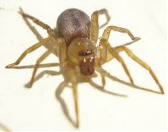Spiders are seldom ignored. Their distinctive appearance, habits, and intricate webs command attention and evoke strong emotions. Given their due, spiders would be prized for their role as predators and natural regulators of insect populations, but because of their appearance and human cultural fears, when one is found to be potentially dangerous, sensationalizing it is irresistible.
There are categorized in the order Araneae. Like their arachnid relatives the mites, spiders live in all parts of the world where they quietly make their way, snaring food in their webs or ambushing insect prey in episodes acted out in minute jungles and deserts. The two-part spider shape is well known. Its head and thorax are combined to make the cephalothorax. Four legs are attached to each side of the cephalothorax. Spider eyes are in front — some have very large eyes. Like all arachnids, spiders have no antennae.
While all spiders are poisonous to some extent, few bite humans. Spider mouthparts, located in front below the eyes, have two short needle-tipped appendages, called chelicerae. These needles, or central fangs, are connected internally to poison sacs. The fangs are used to bite prey (mostly other arthropods) and inject poison to immobilize it. Two short leg-like mouthparts help hold their paralyzed prey, while the chelicerae work back and forth tearing the exoskeleton. As blood wells out, it is sucked into the mouth cavity and ingested. Spiders keep working their prey in this way until all the juices are gone and the remainder is a dry crumbled lump.
The abdomen is located behind the cephalothorax; it is saclike, usually globular. The anal opening is located near the end of the abdomen and close by are some short appendages called the spinnerets. Silk webbing threads out from these spinnerets.
All spiders produce silk, and they use silk in more interesting ways than most other silk producers. Spiders make silk retreats such as tubes and funnels; they make irregular cobwebs as well as the evenly spaced, spiraled great orb webs. Most spiders feed out a dragline wherever they walk and never fall off edges without catching themselves.
While spiders dont have wings, they fly nonetheless, by releasing a thread of silk until it is long enough for the wind to catch it and carry them off — the process is known as ballooning. Newly hatched spider-lings use this method to leave the hatching area.
Two spiders are considered dangerous to humans: the Black Widow and the Brown Recluse. In reality, these two names each represent several species.
TYPES OF SPIDERS
Black Widow Spider
 Female Black Widows have large, round, shiny black abdomens usually decorated with two touching red triangles on the belly. They hang upside down in the web, and more…
Female Black Widows have large, round, shiny black abdomens usually decorated with two touching red triangles on the belly. They hang upside down in the web, and more…
Brown Recluse Spider

Loxosceles reclusa is a dusky-tan or brown spider with the widest range of any recluse spider can be transported in luggage and household furnishings. more…
Aggressive House Spider

This common funnel-weaving spider is found in. Its body is about l/2 inch long; it has a dull tan color with darker markings on its oval abdomen. This spider makes more…
Yellow House Spider

These spiders are about l/4 inch long, with legs & cephalothorax darker than the abdomen. It has been reported as being yellow, white, or greenish. more…


